SACRED GEOMETRY IN GUN FITTING
- bryan457
- Mar 24, 2023
- 12 min read
Sacred Geometry and its Fields of Application
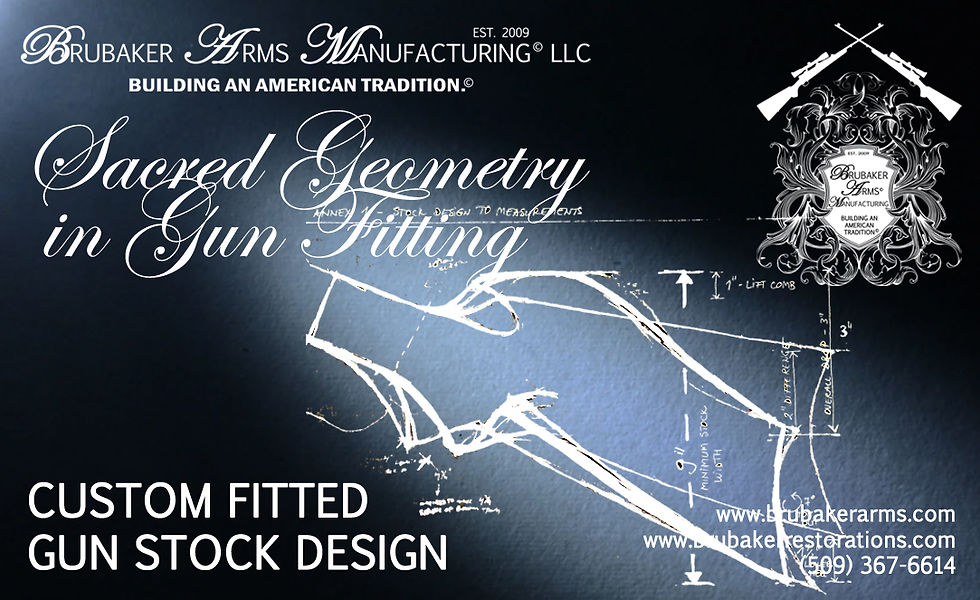
When I studied Architecture back in Europe – before moving to the States – I had no idea that sacred geometry is so prevalent in harmonious gun stock design.
But after a few years of assisting Bryan in designing very custom gun stocks, I started asking myself: “Why do we like this shape for this custom gun stock, and why does the other shape – which is still accurate number wise – simply not work visually?”
I started sketching custom gun stocks and drawing patterns on them; just the same way I studied, for example, the Pantheon, back in university. I used to study the facades of old Italian villas or Roman temples by drawing force lines on the facades. In architecture, a force line represents graphically the internal force acting within a building across imaginary internal surfaces. The force lines show the maximal internal forces and their directions. The closer it gets to the golden ratio and the more it respects the existing force lines of the plot that it is built on, the more pleasing a building becomes to our eyes, although we have no idea why that is. Practically, the force lines focus our eyes towards the focal point and produce an aesthetically pleasant experience as they guide our brain to the elements of a building in a particular succession of images that create a pleasant aesthetical experience.
Mastering the study of force lines in art and architecture is something that can take years of study. My extensive background as an architect provided me with a pair of lenses that helped me recognize sacred geometry principles in custom gun stocks. This is really fascinating, because it means that whatever mesmerized humanity for ages about the Pantheon is what still mesmerizes us today when we admire a well-balanced and properly fitted and designed gun stock.
After studying a few of these phenomenally looking gun stocks that Bryan designed for the customers and that fit them properly and are a joy to look at, I started noticing that there is a particular harmony in lines that is very pleasant to my eyes, that I can’t put my fingers on, but surely, it is there. So I started sketching these force lines on our gun stock designs, and then I realized that all pleasing curves of the gun stock, regardless how curved or crooked it was, had elements of the golden spiral in them. In geometry, a golden spiral is a logarithmic spiral whose growth factor is φ, the golden ratio. That is, a golden spiral gets wider (or further from its origin) by a factor of φ for every quarter turn it makes.

So I started thinking about how architecture and firearms have actually influenced each other tremendously throughout the history. I discovered with surprise that gunmaking and architecture actually share a fundamental connection that is, as far as I have experienced - obscured both from European Architect’s understanding and from the American gunmaker’s understanding.
As a young nation, America doesn’t have a web of military architecture sprinkled across its land, which is easily accessible to the public, like Europe does. So the American gun makers genuinely missed out on experiencing the historical approach of military architecture, which was based almost exclusively on the development of the firearm industry.
At the same time, in today’s modern Europe there is close to no understanding of the spirit of freedom that gives birth to firearm design and development. European Architects miss out on the opportunity to see how the aesthetic principles that they discovered in nature and applied to their masterpieces for centuries, apply to high end firearms. European Architects are taught that firearms had influenced military architecture, but studying the firearms to understand in what way they influenced Architecture is not seen as relevant. There are very few who specialize in military architecture.
My specialization is a Master in Architectural Restoration, which certainly includes military architecture, but it does not exclusively focus on it. However, my final design for the graduation exam had to do with restoring an old military Romanian defense tower that was connected underground, through a series of labyrinths, to a Serbian city. Apparently, that tower was used by the nobles occupying the village to escape in case of war a number of times.
Looking back at my architectural project, I still think it was a fascinating project to work on – however, after living in the United States and doing what I do for a living now, I can certainly make the remark that during the time when I was working on this project, I had absolutely no understanding of firearms. Actually, I have never held or seen in real life, other than behind a piece of glass, in museums – any kind of firearm. In that sense, there is one architectural dialogue that I failed engaging in with that building, while designing the Restoration proposal for it. I wonder what that tower would have had to say about the firearm industry at that time, if I would have known enough to ask those bricks and stones the right questions.
But after studying Bryan’s stocks, I realized that they all respect the golden ration or somehow their curves resemble the golden spiral curves. And I decided to share this exciting discovery with you, because if we know that any custom stock will necessarily follow the golden ratio, it is easier for the gunmaker to master the shape of a new design.
At the same time, since a great number of firearm antiques are commercialized online, it helps antique firearm collectors determine if the image they are looking at is the image of the original stock (or a quality replica), or it is a poor aftermarket stock that was slapped on a fine firearm.
Furthermore, understanding the amount of science and skill that go into designing a custom stock and the amazing results of a project like this, will help the customer understand the length of time needed to produce a one-off stock and the price tag that it comes with.
Specialized stock fitting – why bother?
Off-peg-guns are intended to suit the average shooter with an average build and height. In a sense, they are very much like the “one size fits all” Walmart clothing or the diet recipes that are supposed to work for everyone but don’t.
In addition to not all of us sharing the same size, length of pool, and style of shooting, a high percentage of population is cross eyed dominant. Approximately 69.42% of the population is right-eye dominant and 29% left-eye dominant, with 1.58% of the population with no dominance. People with cross eye dominance do best shooting the unusual “crooked stock”, especially if the eye dominance is not a matter of habit but a matter of strabismus. If people are naturally left handed and left eye dominant, a left handed stock should fix the issue; if the eye dominance is opposite to the hand dominance, left eye dominant people can still learn to shoot with the right eye – they can somehow get used to it in most cases. If the reason for cross eye dominance is strabismus, people generally need to use a “crooked” stock.
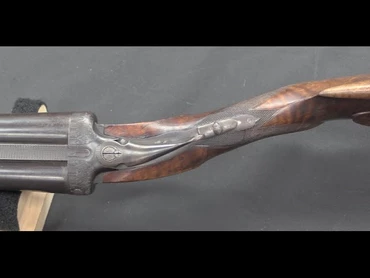

This is a good video explanation of how crippled or crooked gun stocks came to be: https://www.youtube.com/watch?v=_mcVFrk7omk
Gun fitting is more complex than merely making sure the stock is long or short enough. It has to do with the entire physiology of the shooter. Since we possess bodies with natural shapes, regardless how “off” our body proportions are – or how well-proportioned we are – the numbers pulled off a body will still follow the golden ratio and the golden rule that we find in sacred geometry, because God / nature don’t know how to not be natural.
A person with long limbs will very rarely have the torso of a kid (unless a dramatic accident happened), and a tall person will rarely have tiny T-rex arms (*please pause and imagine a T-rex shooting a rifle*).
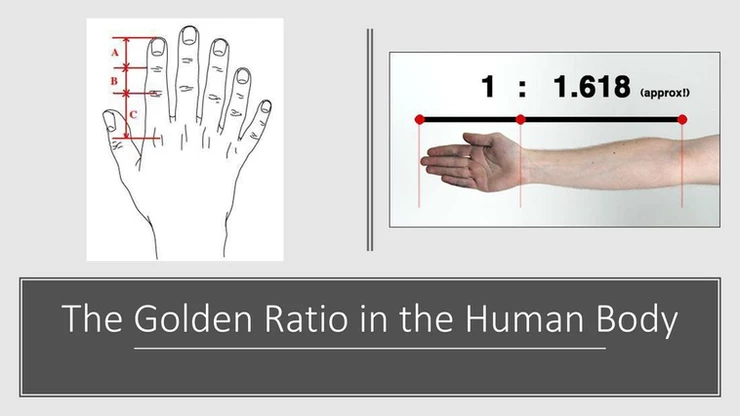
Gun fitting takes in account the shape of the cheek, the shape of the shoulder pocket, the length of pool, the position of the grip, and eye dominance. In other words, gun fitting has to do with designing a tool that is most suitable for your whole body and how you carry yourself.
As a consequence, we discovered that a properly fitted gun stock will necessarily have to respect the golden ratios, since it is designed to fit a human body which is respecting the golden ratio. There are a great number of studies written by architects and aestheticists, on the topic of the golden ratio in the human body, so I will not insist on this aspect. Enough to say that we are so certain that the human body respects the golden ratio, regardless how tall or short or crooked the body is, that Ernst Neufert (15 March 1900 – 23 February 1986), who was a German architect (assistant of the famous Walter Gropius) developed an entire system of architectural design based on the golden ratio found in the human body. Not to mention, Michelangelo had dabbled intensely in studying the proportions of the human body, and left behind an abundance of information that was used as foundation for Neufert’s work.
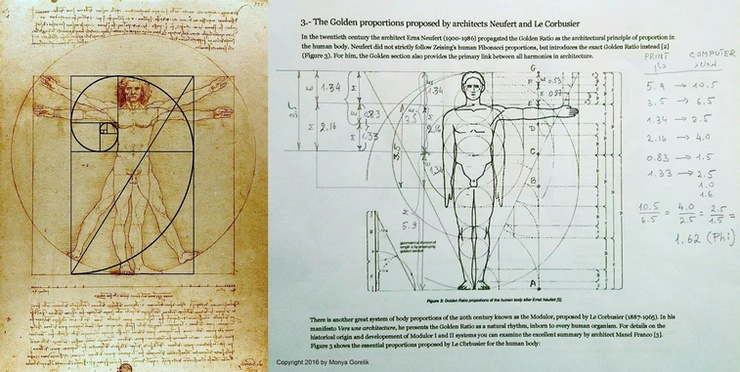
If a gun fits well, then the shooting is more likely to be fluid and accurate.
If it’s wrong, then the gun won’t point exactly where you want it to and your shooting may look tight and ‘snatchy’. Furthermore a badly fitting gun may cause bruising under the shooter’s cheek, on the jawbone, shoulder and forearm. It can also cause injuries to the index finger from the trigger guard.
Gun Fitting Process
The process of designing a custom made stock is quite lengthy. There are a few stages that we have determined (and this process is actually very similar to the process of designing a building.):
1. The Feasibility Study
During this process, the shooter’s body is measured, the intended use of the firearm that the stock is made for is clarified and the costs involved are narrowed down as much as possible. This might be seen as a tedious process, but it is fundamental when it comes to evaluating the projected success of the endeavor. During the feasibility study of the custom gun stock, it might become clear that the investment is not justified for the intended use of the firearm. Or, on the contrary, the feasibility study might reveal that a few more hours of work invested in the stock might increase the accuracy and the fluidity of the shooting so much that the investment is worth the time and money. Designing custom stocks has a lot to do with the physiology of the owner. The face shape, the shoulders shape and broadness, neck length, overall height, arm length, style of shooting and type of shooting (competition, defense, hunting), all these factors influence the shape of the stock. A good gunmaker will – probably more instinctively rather than consciously - know how to apply the golden ratio principles to the stock build. We, at Brubaker Arms, tend to think that this is more of an instinctive knowledge that gunmakers (who are highly crafty and artistically inclined) possess naturally - rather than a conscious applied knowledge; no one on our team has ever heard any gun maker mentioning the golden rules in stock design, yet we discovered that Bryan had always applied these ratios in his designs, without being aware of it. This instinctive know-how might be one of the naturally possessed (or not possessed) skills that make the difference between a good gunmaker and an amateur who can’t find the shapes that make a stock high end. What we know for sure is that in all high-end firearms we designed or consequently looked at, after designing these ratios in our designs, respect the Golden Ratio. When it comes to the way the lines flow, the scroll patterns that are to be engraved on the metal or the checkering patterns – all structural and decorative elements – will respect the Golden Ratio, the perspective effect and the Golden Spiral principles (all discovered by architects). Producing standard stocks that look harmonious is not a big problem, because the stock needs to respect only the golden proportions as there is no shooter to match the stock to. But when the size of the stock and the multi-dimensional aspect of the physiology of the shooter are thrown in the mix, designing a harmonious stock can be a challenge. The Feasibility Study can vary between 5-10 hours of work at the bench, depending on how uncommon the measurements of the shooter are.
2. Making The Pattern
The Pattern is a first 3D sketch of the stock. There are gunmakes who skip this stage, because making a pattern will take about 15-20 hours of labor intensive work. During this stage, the stock design that was sketched on paper will be executed manually on an appropriate piece of low end wood blank. The purpose for making a pattern is trifold. First, it offers the possibility for the gunmaker to make as many modifications as needed. Fine tuning the stock might involve adding gyps build-up on some areas or shaving off a hair. Doing this fine tuning on the final stock is impossible. Second, the pattern can be taken out and used until the customer feels comfortable with it. Sometimes, especially in situations where the stocks need to accommodate for particularly uncommon physiques, the customer will be unable to say if the stock fits him right or if there are any changes that need to be made. Small changes might make a massive difference. Third, the pattern can be saved for further projects. Provided the customer will not go through any significant body changes, one pattern is enough to keep for as many future projects as needed. For this reason, custom stocks are recommended only after the shooters are done growing – teens will need to wait.
3. Duplicating The Pattern
Once the pattern is done, it will be duplicated in the real piece of wood. If the design is particularly personalized, with very particular shapes, it will require quite a bit of hand carving, as machine carving will not be enough to replicate the pattern. During this time, the firearm is usually left with the gunmaker, so the fitting can be done extremely carefully. Duplicating and finishing the pattern to the point where the only things left are applying the finish and the cutting the checkering will take 80-100 hours of skilled, labor intensive work – again, depending on how uncommon the stock is.
4. Finishing and Decorating the Stock
Finishing and decorating the stock is the last stage – and probably the most nerve wracking part – of stock fitting. This is because at this stage, any scratch, any temperature variation and any tool-drop will leave marks that are hard to recover from. The stock needs to have the blend of oils or the varnish put on at particular temperatures for best results, and definitely not in the high or low temperatures, in order to avoid disasters. This process can take up to 50 hours, depending on just how complicated the checkering is and the wood’s level of absorption.
Case Study - Winchester 1873 What led to this analysis of the force lines and ratios in stock design was a very particular study that we did on a Winchester 1873, for a competition shooter. This lady is already a highly capable action shooter competitor; she is often coming home with prizes and honors. However, she is using a fun little Winchester 1873 with a standard stock, which is definitely not fitted for her. Her physique is very unique; her frame is petite and what stands out about her face is the really high cheek bones. So in addition to shortening the stock, when we pulled the numbers off her, this is what we came up with: Length adjustment:
- LOG: 4”
- LOP: 12”
Shape Alterations:
- Really high cheekbones - lift comb with 1’’ above current level
- Lower bottom of heel with 1 ½’’
- Lower comb (top of heel) with 2’’
- Toe out – rotate at 7°
- Cast off – ¼’’
Minimum stock size required – needs to be over-sized quite a bit:
- Minimum length 16"
- Minimum height 9"
- Minimum thickness 2 1/4"
You might realize, looking at these numbers, that they indicate a really interesting shape. So we sat down at the drafting table and drafted for a great number of hours, until we ended up with an over-exaggerated hog back design – which we named the “angel wing” – because it literally looks like an angel wing!
While designing this, we were both looking at the numbers and the shape was simply not pleasing. Bryan locked himself in his office and came out once every hour or so with a sketch: “Does this look right to you?” “No. It’s bulky here.” – or, “The lines don’t flow well here.” Until the end of the day, when he came in the main office with this beautiful angel wing:
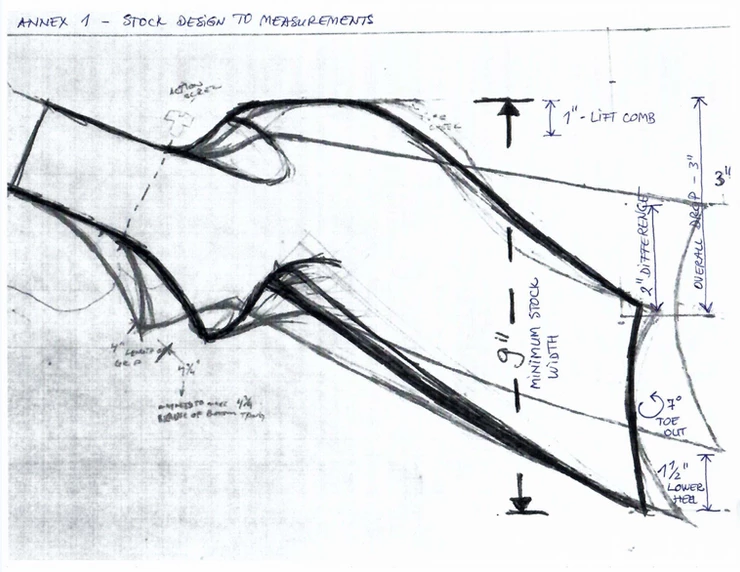
After the design was ready, I scanned it and inserted it in the CAD design software that we use in the office and realized that even with this particularly unique stock, the design became pleasing to our eyes when it reached the point where every line was emulating the Golden Spiral.

Stock design is not only about numbers, it’s about the numbers recreating the negative image of the human body – and doing this while looking appealing to the eye.
Negative space is the space within, between, and around objects. In sketching, negative spaces are actual shapes that share edges (at least partially) with the
positive shape -- the object or objects you are drawing or painting -- thereby creating the outline of your subject. Every positive shape is surrounded by negative space.
Gunfitting is about filling in that space between the cheeks, the pocket shoulder and the tip of the barrel with the most suitably shaped stock that will reduce to 0 seconds the time required to adjust the point of aim. When a fitted stock is thrown on the shoulder, it should fall in the right place and require no adjustment, and the shooting should be perfect. There should be no difference between the point of aim and the point of impact.
The discovery of how sacred geometry can be applied in custom gun making is revolutionary for our shop, and we are certainly looking forward to applying this principle to our upcoming projects.




What an enlightening article. Everything from the 'Golden Ratio' to T-Rex arms (lol). I loved the way you talked the reader through all the phases of custom stock making.
I'd love to see a picture of the final product.
My only questions were, what are LOG LOP?